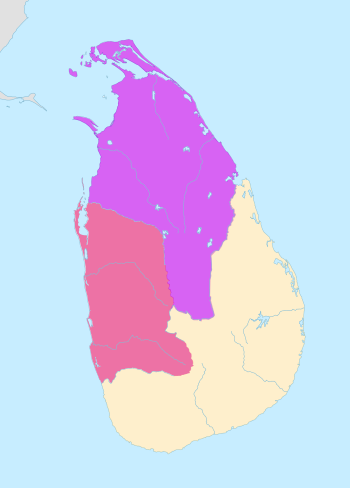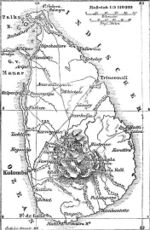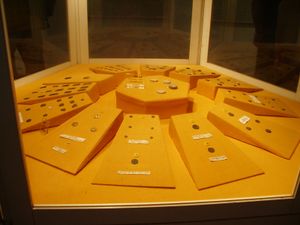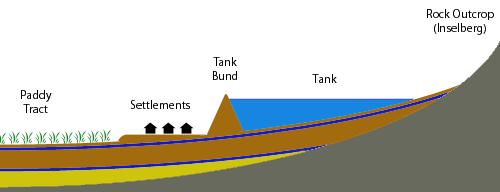مملكة أنوراداپورا
| ||||||||||||||||||||||||||||||||||||||||||||
| ||||||||||||||||||||||||||||||||||||||||||||
مملكة أنوراداپورا (سنهالا: අනුරාධපුර රාජධානිය، وتُنطق: Anurādhapura Rājadhāniya, بالتاميل: அனுராதபுர இராச்சியம்؛ إنگليزية: Anuradhapura Kingdom)، مسماة على اسم عاصمتها، كانت أول مملكة تتأسس في سريلانكا القديمة وفي الشعب السنهالي. أسسها الملك پاندوكابايا في 377 ق.م.، وامتدت سلطة المملكة في أرجاء البلاد، بالرغم من استقلال بعض المناطق من حين لآخر، وهو الأمر الذي تزايد قرب نهاية المملكة. Nonetheless, the king of Anuradhapura was seen as the supreme ruler of the country throughout the Anuradhapura period. Buddhism played a strong role in the Anuradhapura period, influencing its culture, laws, and methods of governance.[N 2] Society and culture were revolutionized when the faith was introduced during the reign of King Devanampiya Tissa; this cultural change was further strengthened by the arrival of the Tooth Relic of the Buddha in Sri Lanka and the patronage extended by her rulers.[7]
Invasions from South India were a constant threat throughout the Anuradhapura period. Rulers such as Dutthagamani, Valagamba, and Dhatusena are noted for defeating the South Indians and regaining control of the kingdom. Other rulers who are notable for military achievements include Gajabahu I, who launched an invasion against the invaders, and Sena II, who sent his armies to assist a Pandyan prince.
Because the kingdom was largely based on agriculture, the construction of irrigation works was a major achievement of the Anuradhapura Kingdom, ensuring water supply in the dry zone and helping the country grow mostly self-sufficient. Several kings, most notably Vasabha and Mahasena, built large reservoirs and canals, which created a vast and complex irrigation network in the Rajarata area throughout the Anuradhapura period. These constructions are an indication of the advanced technical and engineering skills used to create them. The famous paintings and structures at Sigiriya; the Ruwanwelisaya, Jetavana stupas, and other large stupas; large buildings like the Lovamahapaya; and religious works (like the numerous Buddha statues) are landmarks demonstrating the Anuradhapura period's advancement in sculpting.
مدينة أنوراداپورا
In 543 BC, prince Vijaya (543–505 BC) arrived in Sri Lanka, having been banished from his homeland in India. He eventually brought the island under his control and established himself as king. After this, his retinue established villages and colonies throughout the country. One of these was established by Anuradha, a minister of King Vijaya, on the banks of a stream called Kolon and was named Anuradhagama.[8]
In 377 BC, King Pandukabhaya (437–367 BC) made it his capital and developed it into a prosperous city.[9][10] Anuradhapura (Anurapura) was named after the minister who first established the village and after a grandfather of Pandukabhaya who lived there. The name was also derived from the city's establishment on the auspicious asterism called Anura.[11] Anuradhapura was the capital of all the monarchs who ruled the country in the Anuradhapura Kingdom, with the exception of Kashyapa I (473–491), who chose Sigiriya to be his capital.[12] The city is also marked on Ptolemy's world map.[13]
التجارة والاقتصاد
الثقافة
الدين
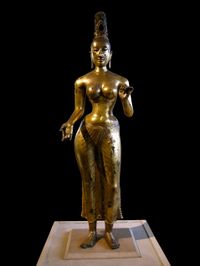
انظر أيضاً
ملاحظات
- ^ This flag, depicting the moon, sun and a lion bearing a sword, is believed to have been used as the royal standard of Dutthagamani, and subsequent rulers.[1]
- ^ Buddhism was such an important factor in this period that Mendis (2000), p.196 asserts, "The island of Lanka belonged to the Buddha himself; it was like a treasury filled with the three gems".
المراجع
الهامش
- ^ "Sri Lanka's National Flag". The Sunday Times. 2008-02-03. Retrieved 2009-07-04.
- ^ De Silva 2014, p. 58.
- ^ "The downfall of the Anuradhapura kingdom and South Indian influences" (PDF). Retrieved 2018-01-03.
- ^ Chander, Prakash (1 Jan 2003). India 2003: Past and Present (1st ed.). APH Publishing Corporation. p. 112. ISBN 978-8176484558. Retrieved 19 August 2014.
- ^ Ravana - The Great King of Lanka - M.S. Purnalingam Pillai - Google Books. Books.google.com. Retrieved 2014-08-20.
- ^ Wilson, H. H. (1839). "Account of the Foe Kue Hi". The Journal of the Royal Asiatic Society. Ulan Press: 135. Retrieved 19 August 2014.
- ^ Perera (2001), p.45
- ^ Wijesooriya (2006), p. 20
- ^ Blaze (1995), p. 19
- ^ Yogasundaram (2008), p. 41
- ^ Wijesooriya (2006), p. 27
- ^ Bandaranayake (2007), p. 6
- ^ Mendis (1999), p. 7
ببليوگرافيا
- De Silva, K. M. (2014). A history of Sri Lanka ([Revised.] ed.). Colombo: Vijitha Yapa Publications. ISBN 978-955-8095-92-8.
- Bandaranayake, Senake (2007). Sigiriya. Central Cultural Fund. ISBN 978-955-613-111-6.
- Basnayake, H. T. (1986). Sri Lankan Monastic Architecture. Sri Satguru Publications. ISBN 978-81-7030-009-0.
- Blaze, L. E (1995). The Story of Lanka. Asian Educational Services. ISBN 978-81-206-1074-3.
- Codrington, H.W. (1994). Ceylon Coins and Currency. Asian Educational Services. ISBN 978-81-206-0913-6.
- Ellawala, H. (1969). Social History of Early Ceylon. Department of Cultural Affairs.
- Fernando, G. S. (2001). සිංහල සැරසිලි—Sinhala Sarasili [Sinhala Decorational Art] (in Sinhala). M. D. Gunasena and Company. ISBN 978-955-21-0525-8.
{{cite book}}: CS1 maint: unrecognized language (link) - Gooneratne, W.; Hirashima, S. (1990). Irrigation and Water Management in Asia. Sterling Publishers.
- Lokubandara, W. J. M. (2007). The Mistique of Sigiriya — Whispers of the Mirror Wall. Godage International Publishers. ISBN 978-955-30-0610-3.
- Ludowyk, E. F. C. (1985). The Story of Ceylon. Navrang Booksellers & Publishers. ISBN 978-81-7013-020-8.
- Mendis, Ranjan Chinthaka (1999). The Story of Anuradhapura. Lakshmi Mendis. ISBN 978-955-96704-0-7.
- Mendis, Vernon L. B. (2000). The Rulers of Sri Lanka. S. Godage & Brothers. ISBN 978-955-20-4847-0.
- Moratuwagama, H. M. (1996). සිංහල ථුපවංසය—Sinhala Thupavansaya [Sinhala Thupavamsa] (in Sinhala). Rathna Publishers. ISBN 978-955-569-068-3.
{{cite book}}: CS1 maint: unrecognized language (link) - Nicholas, C. W.; Paranavitana, S. (1961). A Concise History of Ceylon. Colombo University Press.
- Perera, Lakshman S. (2001). The Institutions of Ancient Ceylon from Inscriptions. Vol. 1. International Centre for Ethnic Studies. ISBN 978-955-580-055-6.
- Rambukwelle, P. B. (1993). Commentary on Sinhala Kingship — Vijaya to Kalinga Magha. Sridevi Printers. ISBN 978-955-95565-0-3.
- Sastri, K. A (2000) [1935]. The CōĻas. Madras: University of Madras.
{{cite book}}: Cite has empty unknown parameter:|coauthors=(help) - Seneviratna, Anuradha (1989). The Springs of Sinhala Civilization. Navrang Booksellers & Publishers. LCCN 89906331. OCLC 21524601.
- Siriweera, W. I. (2004). History of Sri Lanka. Dayawansa Jayakodi & Company. ISBN 978-955-551-257-2.
- Siriweera, W. I. (1994). A Study of the Economic History of Pre Modern Sri Lanka. Vikas Publishing House. ISBN 978-0-7069-7621-2.
- Wijesooriya, S. (2006). A Concise Sinhala Mahavamsa. Participatory Development Forum. ISBN 978-955-9140-31-3.
- Yogasundaram, Nath (2008). A Comprehensive History of Sri Lanka. Vijitha Yapa Publishers. ISBN 978-955-665-002-0.
- Spencer, George W. (May 1976). "The Politics of Plunder:The Cholas in Eleventh-Century Ceylon". The Journal of Asian Studies. 35 (3): 405–419. doi:10.2307/2053272. JSTOR 2053272.
قالب:Anuradhapura period قالب:Sinhalese Monarchy قالب:Monarchs of the Anuradhapura Kingdom
- Short description is different from Wikidata
- Pages using infobox country or infobox former country with the flag caption or type parameters
- Articles containing سنهالا-language text
- Articles containing تاميلية-language text
- Articles containing إنگليزية-language text
- Pages using Lang-xx templates
- دول وأقاليم تأسست في القرن الرابع ق.م.
- تأسيسات القرن الرابع ق.م. في سريلانكا
- 377 ق.م.
- دول وأقاليم انحلت في 1017
- مملكة أنوراداپورا
- ممالك سريلانكا
- انحلالات 1017 في آسيا
- انحلالات القرن 11 في سريلانكا
- تأسيسات عقد 370 ق.م.

